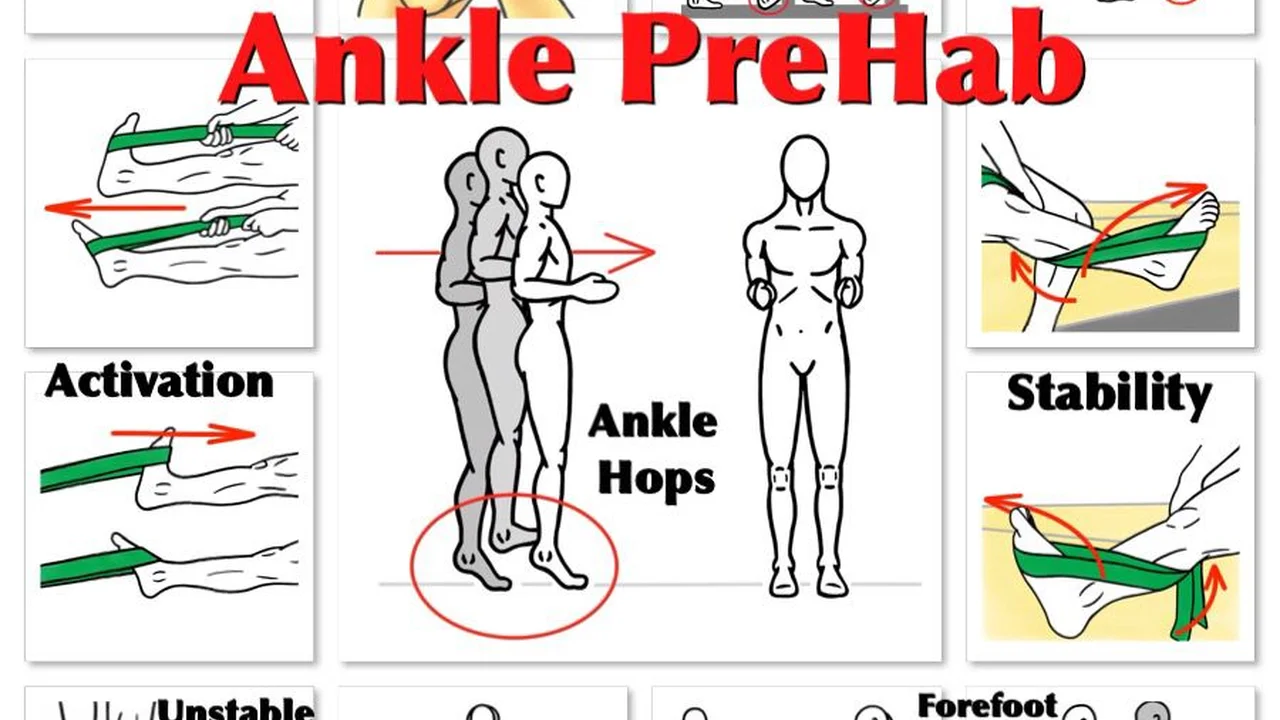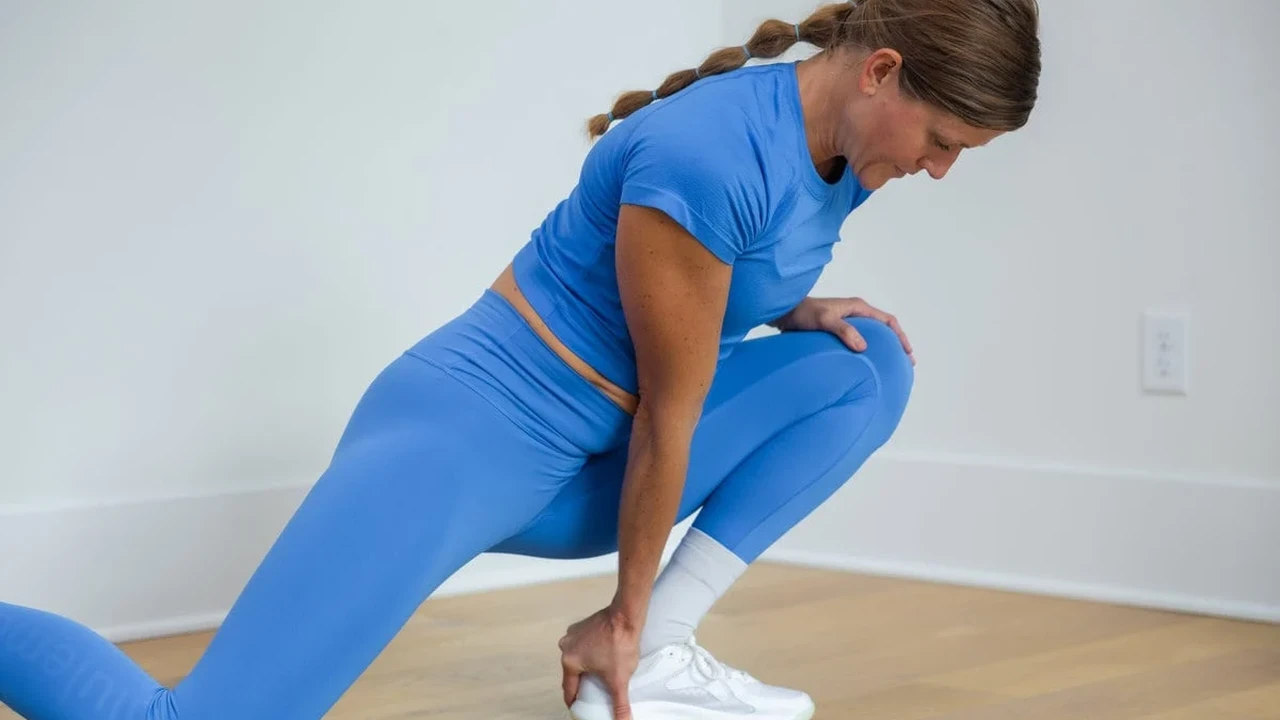Ankle Strengthening Exercises: A Complete Guide

Understanding Common Ankle and Foot Injuries
The ankle and foot are complex structures, bearing the brunt of our daily activities. Consequently, they are susceptible to a wide range of injuries. Understanding the nature of these injuries is the first step towards effective recovery and prevention.
Sprains and Strains A Detailed Look
Ankle sprains are among the most common musculoskeletal injuries, often occurring when the foot twists or rolls beyond its normal range of motion. This can damage the ligaments, the tough bands of tissue that connect bones. Strains, on the other hand, involve the stretching or tearing of muscles or tendons. Both sprains and strains can range in severity from mild discomfort to debilitating pain.
Causes of Sprains and Strains: Common causes include sudden impacts, awkward landings, uneven surfaces, and inadequate warm-up routines before physical activity. Athletes participating in sports like basketball, soccer, and volleyball are particularly at risk.
Symptoms: Symptoms of ankle sprains and strains typically include pain, swelling, bruising, stiffness, and difficulty bearing weight. In severe cases, a popping sound may be heard at the time of injury.
Treatment: The initial treatment for sprains and strains often involves the RICE protocol: Rest, Ice, Compression, and Elevation. Over-the-counter pain relievers can help manage pain and inflammation. Physical therapy may be recommended to restore range of motion, strength, and stability.
Fractures Identifying and Addressing Bone Breaks
A fracture is a break in a bone. Ankle and foot fractures can occur due to high-impact trauma, such as falls, car accidents, or sports injuries. Stress fractures, tiny cracks in the bone, can also develop from repetitive stress and overuse.
Causes of Fractures: As mentioned, high-impact trauma is a primary cause. Stress fractures are often seen in runners and athletes who engage in repetitive weight-bearing activities.
Symptoms: Symptoms of a fracture include severe pain, swelling, bruising, deformity, and inability to bear weight. A stress fracture may present with a gradual onset of pain that worsens with activity.
Treatment: Treatment for fractures depends on the severity and location of the break. A cast, splint, or boot may be used to immobilize the injured area and allow the bone to heal. In some cases, surgery may be necessary to realign the bone fragments.
Achilles Tendinitis Understanding the Inflammation
Achilles tendinitis is an inflammation of the Achilles tendon, the large tendon that runs along the back of the ankle and connects the calf muscles to the heel bone. It often results from overuse, improper footwear, or inadequate stretching.
Causes of Achilles Tendinitis: Common causes include sudden increases in activity level, tight calf muscles, poor footwear, and running on hard surfaces.
Symptoms: Symptoms of Achilles tendinitis include pain, stiffness, and tenderness along the Achilles tendon. The pain may worsen with activity and improve with rest.
Treatment: Treatment typically involves rest, ice, compression, and elevation (RICE). Stretching and strengthening exercises can help improve flexibility and reduce stress on the tendon. Orthotics, such as heel lifts, may also be recommended.
Plantar Fasciitis Managing Heel Pain
Plantar fasciitis is a common condition that causes heel pain. It occurs when the plantar fascia, a thick band of tissue that runs along the bottom of the foot from the heel to the toes, becomes inflamed.
Causes of Plantar Fasciitis: Common causes include overuse, flat feet, high arches, tight calf muscles, obesity, and improper footwear.
Symptoms: The primary symptom of plantar fasciitis is heel pain, which is often worse in the morning or after periods of rest. The pain may decrease with activity but return after prolonged standing or walking.
Treatment: Treatment typically involves rest, ice, stretching, and supportive footwear. Orthotics, such as arch supports, can help cushion the heel and reduce stress on the plantar fascia. Physical therapy and night splints may also be recommended.
Effective Treatment Options for Ankle and Foot Injuries
The treatment of ankle and foot injuries varies depending on the type and severity of the injury. However, some common treatment options are often employed.
The RICE Protocol A Foundation for Recovery
As mentioned earlier, the RICE protocol (Rest, Ice, Compression, and Elevation) is a cornerstone of initial treatment for many ankle and foot injuries. It helps reduce pain, swelling, and inflammation.
Rest: Avoid activities that aggravate the injury. This may involve limiting weight-bearing or using crutches for support.
Ice: Apply ice packs to the injured area for 15-20 minutes at a time, several times a day. This helps reduce swelling and pain.
Compression: Use a compression bandage to wrap the injured area. This helps reduce swelling and provides support.
Elevation: Elevate the injured foot or ankle above the heart. This helps reduce swelling by promoting fluid drainage.
Physical Therapy Restoring Function and Mobility
Physical therapy plays a crucial role in the rehabilitation of ankle and foot injuries. A physical therapist can develop a personalized treatment plan to restore range of motion, strength, and stability.
Exercises: Physical therapy exercises may include stretching, strengthening, balance training, and proprioceptive exercises (exercises that improve awareness of body position).
Modalities: Modalities such as ultrasound, electrical stimulation, and heat or cold therapy may be used to reduce pain and inflammation.
Medications Managing Pain and Inflammation
Over-the-counter pain relievers, such as ibuprofen and naproxen, can help manage pain and inflammation. In some cases, a doctor may prescribe stronger pain medications or anti-inflammatory drugs.
Caution: It's important to follow the dosage instructions and consult with a doctor or pharmacist before taking any medications, especially if you have any underlying health conditions or are taking other medications.
Orthotics Providing Support and Alignment
Orthotics are custom-made or over-the-counter shoe inserts that provide support and alignment to the foot and ankle. They can help reduce pain and improve function in a variety of conditions, such as plantar fasciitis, flat feet, and high arches.
Types of Orthotics: Orthotics can be custom-made to fit the individual's foot or purchased over-the-counter. Custom orthotics are generally more effective, but they are also more expensive. Over-the-counter orthotics can be a good option for mild to moderate conditions.
Surgery When Necessary
Surgery is typically reserved for severe ankle and foot injuries that do not respond to conservative treatment. Surgical procedures may be necessary to repair torn ligaments, fractured bones, or damaged tendons.
Recovery: Recovery from surgery can be lengthy and may require extensive physical therapy.
Preventing Ankle and Foot Injuries Proactive Strategies
Prevention is always better than cure. There are several steps you can take to reduce your risk of ankle and foot injuries.
Proper Footwear Choosing the Right Shoes
Wearing appropriate footwear is essential for preventing ankle and foot injuries. Choose shoes that provide good support, cushioning, and stability. Avoid shoes that are too tight, too loose, or have high heels.
Specific Recommendations: * Running Shoes: Look for shoes with good cushioning and support to absorb impact. * Walking Shoes: Choose shoes with a flexible sole and good arch support. * Work Boots: Select boots that provide ankle support and protection from hazards.
Warm-Up and Stretching Preparing Your Body
Warming up and stretching before physical activity can help prepare your muscles and ligaments for exercise, reducing the risk of injury.
Recommended Stretches: Calf stretches, Achilles tendon stretches, and ankle circles are all beneficial.
Strengthening Exercises Building Stability
Strengthening the muscles around the ankle and foot can improve stability and reduce the risk of sprains and strains.
Recommended Exercises: Ankle strengthening exercises, such as calf raises, heel raises, and toe raises, are effective.
Balance Training Enhancing Proprioception
Balance training can improve proprioception, which is the body's ability to sense its position in space. This can help prevent falls and ankle sprains.
Recommended Exercises: Standing on one leg, using a wobble board, or practicing yoga are all good options.
Paying Attention to Your Body Listening to Signals
Pay attention to your body and stop activities if you experience pain or discomfort. Pushing through pain can worsen an injury and prolong recovery.
Product Recommendations for Ankle and Foot Injury Recovery and Prevention
Several products can aid in the recovery from and prevention of ankle and foot injuries. Here are some recommendations, along with their use cases, comparisons, and pricing details.
Ankle Braces Providing Support and Stability
Ankle braces provide support and stability to the ankle joint, helping to prevent sprains and strains. They can be particularly useful for athletes or individuals who have a history of ankle injuries.
Use Cases: Ankle braces are commonly used during sports activities, such as basketball, volleyball, and soccer. They can also be used for everyday activities, such as walking or hiking, to provide extra support.
Product Comparison:
* ASO Ankle Stabilizer: A popular choice for its lightweight design and excellent support. It features a figure-eight strapping system that mimics the taping techniques used by athletic trainers. * Pros: Lightweight, comfortable, excellent support. * Cons: Can be bulky with certain shoes. * Pricing: Approximately $30-$40. * McDavid Ankle Brace: Known for its hinged design, which allows for a more natural range of motion while still providing support. * Pros: Good range of motion, durable, adjustable. * Cons: Can be more expensive than other options. * Pricing: Approximately $40-$50. * DonJoy Performance Webtech Ankle Brace: Offers a unique web design that provides targeted support and helps to dissipate energy from impacts. * Pros: Targeted support, breathable, comfortable. * Cons: May not be suitable for all types of injuries. * Pricing: Approximately $50-$60.Orthotic Inserts Supporting Your Arches
Orthotic inserts provide support and cushioning to the arches of the feet, helping to alleviate pain and improve alignment. They can be particularly beneficial for individuals with plantar fasciitis, flat feet, or high arches.
Use Cases: Orthotic inserts can be used in a variety of shoes, including athletic shoes, dress shoes, and work boots. They can help reduce pain and fatigue during walking, standing, and other activities.
Product Comparison:
* Superfeet Green Premium Insoles: A popular choice for their firm support and durability. They are designed to provide long-lasting support and help improve biomechanics. * Pros: Excellent support, durable, helps with alignment. * Cons: Can be expensive, may require a break-in period. * Pricing: Approximately $40-$50. * Powerstep Pinnacle Orthotic Inserts: Offer a balance of support and cushioning. They are designed to provide comfortable support and help reduce pain. * Pros: Comfortable, good support, affordable. * Cons: May not be as durable as other options. * Pricing: Approximately $30-$40. * Dr. Scholl's Custom Fit Orthotic Inserts: Available at many drugstores, these inserts allow you to customize the level of support based on your foot type. * Pros: Customizable, readily available, affordable. * Cons: May not provide as much support as custom-made orthotics. * Pricing: Approximately $50-$60.Foam Rollers Relieving Muscle Tension
Foam rollers are used to release muscle tension and improve flexibility. They can be particularly helpful for individuals with tight calf muscles or plantar fasciitis.
Use Cases: Foam rollers can be used before and after exercise to improve flexibility and reduce muscle soreness. They can also be used to release trigger points and improve circulation.
Product Comparison:
* TriggerPoint GRID Foam Roller: Features a unique grid pattern that provides varying levels of massage intensity. * Pros: Durable, versatile, effective for muscle release. * Cons: Can be painful for some users. * Pricing: Approximately $30-$40. * AmazonBasics High-Density Round Foam Roller: A more affordable option that provides basic muscle release. * Pros: Affordable, simple to use, good for beginners. * Cons: May not be as durable as other options. * Pricing: Approximately $15-$20. * RumbleRoller: Features firm, bumpy protrusions that provide deep tissue massage. * Pros: Deep tissue massage, durable, effective for trigger points. * Cons: Can be very painful, not suitable for all users. * Pricing: Approximately $50-$60.Compression Socks Enhancing Circulation
Compression socks help improve circulation and reduce swelling. They can be particularly beneficial for individuals who spend long periods of time standing or sitting.
Use Cases: Compression socks are commonly used by athletes, nurses, travelers, and individuals with poor circulation.
Product Comparison:
* SB SOX Compression Socks: A popular choice for their comfortable fit and effective compression. * Pros: Comfortable, effective compression, durable. * Cons: Can be difficult to put on. * Pricing: Approximately $15-$20 per pair. * Physix Gear Sport Compression Socks: Offer a variety of compression levels and styles. * Pros: Wide range of options, comfortable, affordable. * Cons: May not be as durable as other options. * Pricing: Approximately $20-$25 per pair. * CEP Compression Socks: Known for their high-quality materials and graduated compression. * Pros: High-quality, graduated compression, durable. * Cons: Can be expensive. * Pricing: Approximately $40-$50 per pair.Ice Packs Reducing Swelling and Pain
Ice packs are used to reduce swelling and pain. They are an essential part of the RICE protocol and can be used for a variety of ankle and foot injuries.
Use Cases: Ice packs can be used after injuries, after exercise, or any time you experience pain or swelling.
Product Comparison:
* Reusable Gel Ice Pack: A versatile and reusable option. * Pros: Reusable, versatile, affordable. * Cons: Can be bulky. * Pricing: Approximately $10-$15. * Instant Cold Pack: A convenient option for on-the-go use. * Pros: Convenient, portable, readily available. * Cons: Single-use, can be expensive. * Pricing: Approximately $2-$5 per pack. * Ice Wrap: Combines ice and compression for targeted relief. * Pros: Targeted relief, compression, comfortable. * Cons: Can be more expensive than other options. * Pricing: Approximately $20-$30.Living Well with Ankle and Foot Injuries Long-Term Management
While recovering from an ankle or foot injury can be challenging, with proper care and management, you can regain your mobility and enjoy an active lifestyle. Long-term management is key to preventing re-injury and maintaining overall foot health.
Continued Exercise Maintaining Strength and Flexibility
Even after you've recovered from an injury, it's important to continue performing strengthening and stretching exercises to maintain strength and flexibility in your ankles and feet. This will help prevent future injuries and improve overall function.
Weight Management Reducing Stress on Joints
Maintaining a healthy weight can significantly reduce the stress on your ankles and feet. Excess weight puts extra strain on these joints, increasing the risk of injury and pain. A balanced diet and regular exercise can help you maintain a healthy weight.
Regular Check-Ups Monitoring Foot Health
Regular check-ups with a podiatrist can help monitor your foot health and identify any potential problems early on. A podiatrist can provide guidance on proper footwear, orthotics, and other treatments to help you maintain healthy feet.
Listening to Your Body Paying Attention to Pain Signals
It's crucial to listen to your body and pay attention to any pain signals. If you experience pain in your ankles or feet, stop the activity and rest. Ignoring pain can lead to more serious injuries and prolong recovery.
Modifying Activities Adapting to Limitations
If you have a history of ankle or foot injuries, you may need to modify your activities to avoid re-injury. This may involve choosing lower-impact activities, wearing supportive footwear, and avoiding uneven surfaces.
:max_bytes(150000):strip_icc()/277019-baked-pork-chops-with-cream-of-mushroom-soup-DDMFS-beauty-4x3-BG-7505-5762b731cf30447d9cbbbbbf387beafa.jpg)






